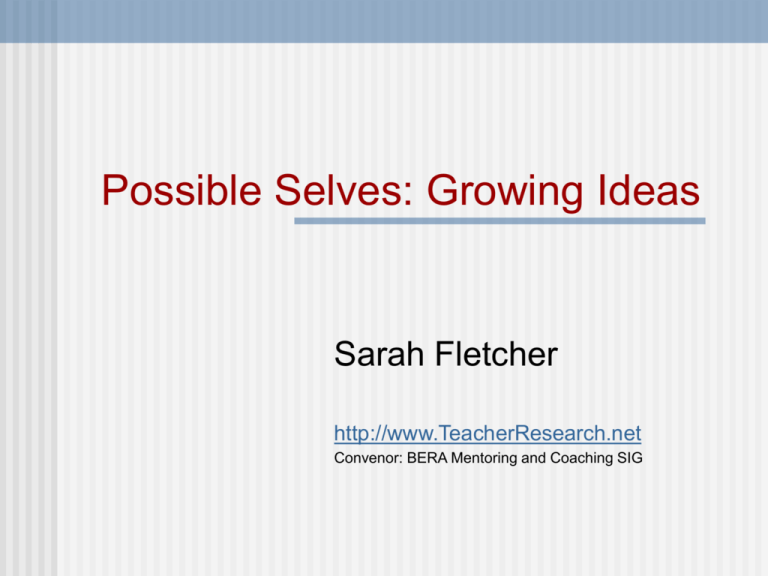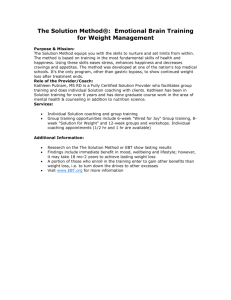BCX_170308_possible_selves
advertisement

Possible Selves: Growing Ideas Sarah Fletcher http://www.TeacherResearch.net Convenor: BERA Mentoring and Coaching SIG A picture paints 1000 words? Which emotions do you see? Bristol Coaching Exchange Workshop 17 March 2008: What is authentic ‘happiness’? What is ‘Appreciative Inquiry’ (AI)? How do positive ‘Possible Selves’ (PS) fit in? What use might all this be in my coaching? What evidence is there that PS and AI work? What are potential benefits of PS & AI? Realizing creative, imaginative potential Nurturing growth in taking responsibility Easing anxiety and depression Useful resources: http://appreciativeinquiry.case.edu/ http://www.authentichappiness.sas.upenn.edu/questionnaires.aspx http://news.bbc.co.uk/1/hi/programmes/happiness_formula/4783836.stm What is ‘happiness’? What makes you really happy? What makes you happy when at work? How far do you work at being happier? What happy daydreams do you have? How far do you spread happiness? Does feeling positive increase happiness? What is Appreciative Inquiry (AI)? Appreciative Inquiry utilizes a 4-stage process focusing on: DISCOVER: The identification of organizational processes that work well. DREAM: The envisioning of processes that would work well in the future. DESIGN: Planning and prioritizing processes that would work well. DESTINY (or DELIVER): The implementation (execution) of the proposed design. The basic idea is to build organizations around what works, rather than trying to fix what doesn't. It is the opposite of problem solving What are Positive Selves (PS)? Positive selves can be consciously conjured up in pursuit of desired goals which can be positively construed. Positive selves motivate by giving a clear goal to strive for and by energising the individual to pursue actions necessary for attaining a possible positive self. Step One: Introduction Who do I think I am right now? What are my professional values? What are my best professional skills? Where is my professional knowledge? What are my current work-based targets? Who do I want to be? What are my dreams? Step Two: My PS + My AI Try drawing a stick figure of you at work: What does your face look like? Happy? What’s written in your thought bubble? What are you busy doing as you work? Where are your close friends? At work? How do you feel as you look at yourself? Are you the person you dream of being? Step Three: Coaching for mapping How do you see yourself right now? How do we map your journey to your PS? What happens between now and then? How long will your journey take you? How will you feel along the way? Who might be alongside you? Step Four: Coaching for dreaming! What dreams give you energy in life? How do you use that energy at work ? How are you living out dreams at work? Which aspects of work satisfy you most? Where might you extend that satisfaction? How will you bring dreaming into working? Step Five: Self coaching What am I good at? (How do I know?) (Use ‘Authentic Happiness’ Questionnaires?) Step Six: Self Coaching What might I improve? Step Seven: Self Coaching What do I like most about me? Who can help me develop the parts I like best? Step Nine: Self Coaching What am I afraid of and could avoid? How will I overcome my fears? Who will help me to overcome them? What’s my plan to reach my PS? By tomorrow By this Friday By December By 5 years hence How will I record what I achieve? How will I know I am living my dream? Action research: formulaic and technicist? According to Cooperrider and Srivastva: ‘…Action research has largely failed as an instrument for advancing social knowledge of consequence and now risks being (mis) understood as little more than crude empiricism imprisoned in a deficiency mode of thought.’ Action research: generative incapacity ‘Action research tends to build into the client system an institutionalized pattern for continuously collecting data and examining the system’s processes as well as for the continuous review of known problem areas. Problem solving becomes very much a way of organizational life…’ Marguiles and Raia Appreciative Inquiry: A sense of wonder returns Action research’s problem solving view of the world is a primary restraint on its imagination, passion and positive contribution… appreciative inquiry represents a viable complement to conventional forms of action research, one uniquely suited to social innovation instead of problem solving’ Cooperrider and Srivasrtva Fletcher (2000) (a) Extract from my personal diary dated 1987. ‘The moment I knew I was healing myself was one of the funniest I shall ever remember. Encased in plaster from just below my armpits to my knee there was ‘I’ seeing myself running, dancing and playing with friends on a beach! Momentary projection. Pain, searing pain macheteing through my visualization – don’t panic! Hold, hold on to the certainty that you will not falter in experiencing health. Draw from your being this agony and gently, gently ease it into vision. Initially, so all pervasive, this pain becomes a ball. Initially so immobile, it begins to move – it becomes a BALL! It bounces – I can play – and there I am – a child with a ball – a ball of pain. What do I do with this ball? Easy! I colour this ball, add stripes and fair-isle patterns like knitwear … This ball of pain – this pain ball – no longer daunts me! I have a choice – an ultimate choice – to let it return to all-embracing agony – or to retain the ball, I bounce this ridiculous sphere round the walls of my imagination – it loses its horror and I am reborn as a new ‘self’; a self that knows health is closer.’






